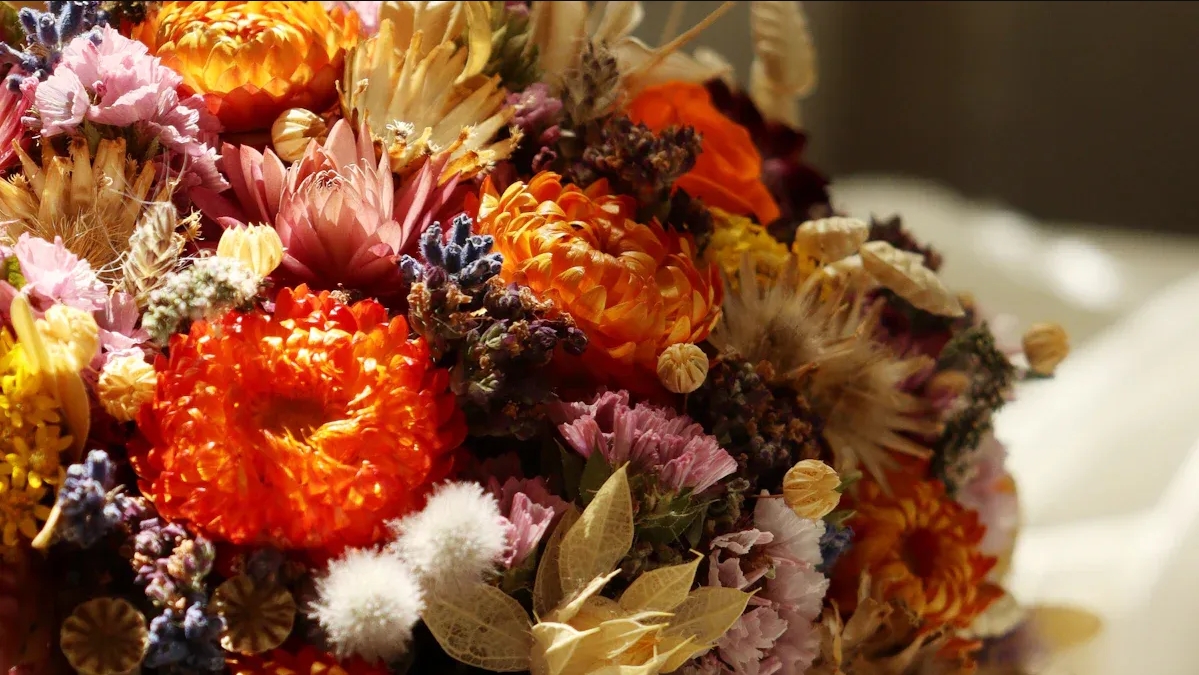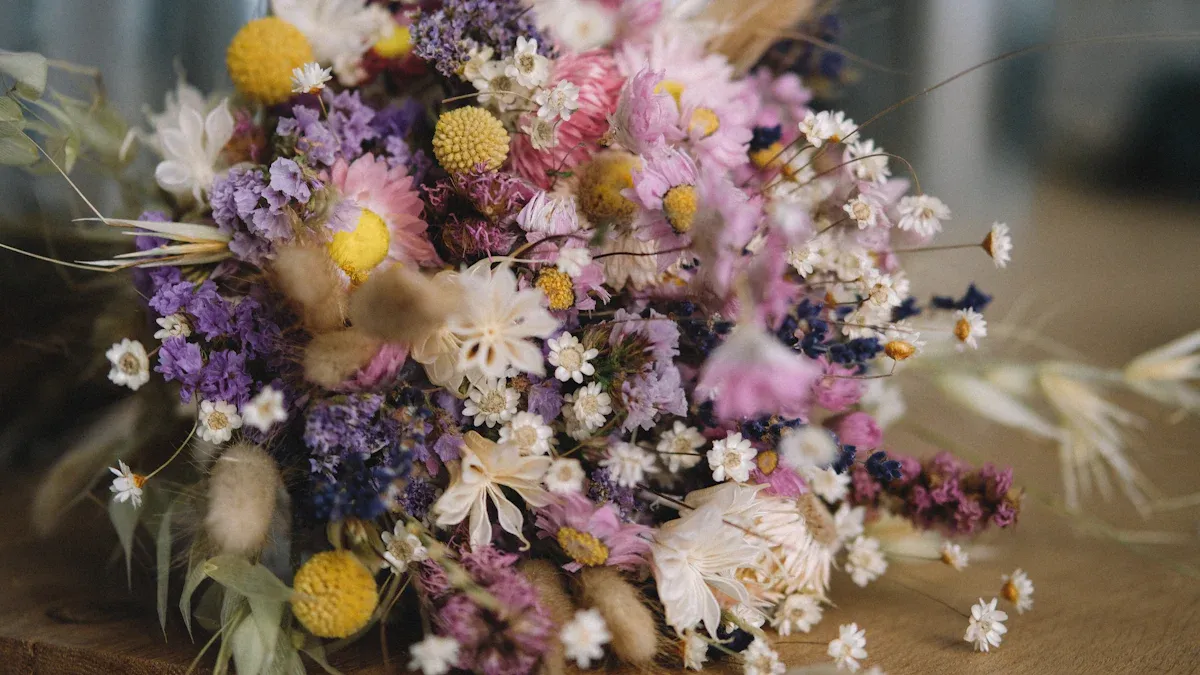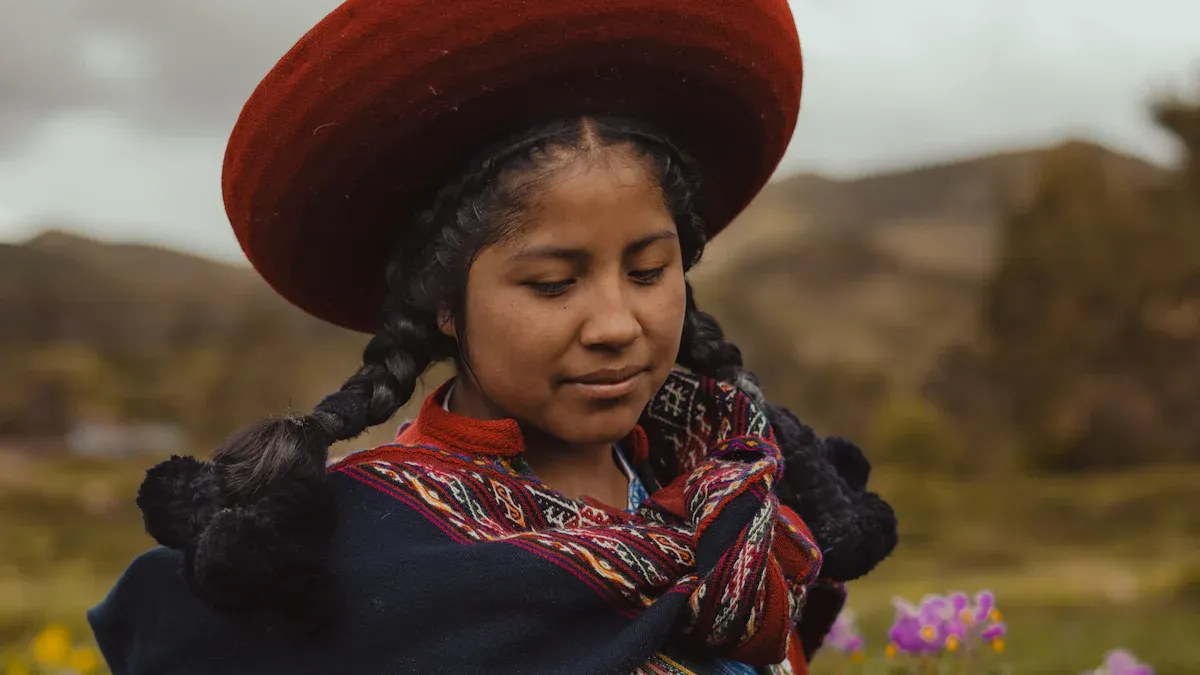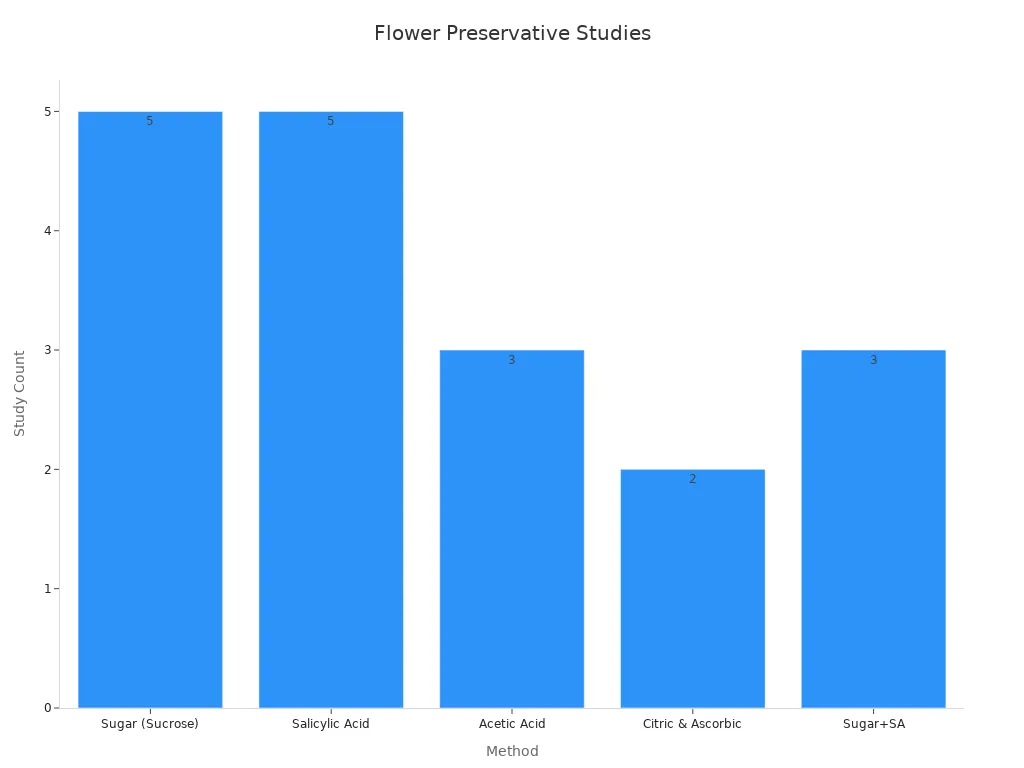Preserved Flower arrangements show nature’s beauty for a long time. Fresh flowers do not last as long as these. Currently the dried flower market is dominated by dried baby's breath, dried lavender, dried eucalyptus, dried hydrangeas, dried thistles, dried pampas grass, dried orchids, dried peonies, dried bluebells, dried wheat. Many people keep them to remember special times. They use them to share feelings when words are not enough. Studies say floral keepsakes help people with their feelings. They also help people remember memories. This supports people’s emotional health. Preserved Flowers meaning is about love that lasts. It is also about special memories and keeping important moments.
Key Takeaways
Preserved flowers help memories last longer than fresh flowers. They help people remember special times and loved ones. Colors and types of preserved flowers have special meanings. People can show love, friendship, hope, and respect without speaking. Many cultures use preserved flowers in their traditions and ceremonies. They use them to honor the past and celebrate big events. Preserved flowers are pretty and easy to care for at home. They last for months or even years and are good for the environment. Special ways of drying and saving flowers keep them looking new. These flowers help people feel happy and calm by keeping important memories.
Emotional Significance
Memory and Remembrance
Preserved flowers help people remember important times in life. Many people save a bouquet from a wedding or graduation. These flowers help people keep memories after the event is over. A study from Rutgers University says 77% of people feel happier when they see flowers that remind them of special times (Rutgers Study).
Preserved flowers can make a short moment last longer. They help people remember their feelings when they see or touch the flowers.
Some families use preserved flowers to remember loved ones who have died. These flowers give comfort and help people heal. They show strength and help people feel better during hard times. The bond with these keepsakes can help mental health and bring peace.
Love and Sentiment

Preserved flowers show feelings when words are not enough. People give them as gifts to show love, friendship, or thanks. Preserved flowers last much longer than fresh ones. This makes them a lasting way to show care and love.
A survey by the Society of American Florists found that 88% of people feel special when they get flowers (SAF Survey). Preserved flowers keep this feeling going because they do not fade fast. They help people remember the good times shared with others. Each flower and color can mean something different, making the gift special.
People pick preserved roses for anniversaries.
Friends give dried bouquets to celebrate big moments.
Families keep preserved flowers to show they are together.
Preserved flowers hold feelings and keep them safe. They help people celebrate love, remember the past, and hope for the future.
Preserved Flowers Meaning

Symbolism of Colors
Colors are very important in the cultural significance. Each color has its own message. People use colors to show feelings without talking. This idea comes from the language of flowers. It helps people share emotions in a simple way.
Color |
Symbolic Meanings |
Common Use Cases |
|---|---|---|
Red |
Love, passion, eternal love |
Anniversaries, romantic gifts |
White |
Purity, innocence, emotional connection |
Weddings, sympathy bouquets |
Yellow |
Friendship, hope and freedom |
Celebrations, get-well gifts |
Blue |
Protection and loyalty |
Friendship, encouragement |
Pink |
Admiration, sweetness |
Birthdays, thank-you gifts |
Purple |
Royalty, dignity |
Special occasions, respect |
Red preserved roses stand for love that never ends. People give them to show strong feelings. They are used at weddings and memorials. Yellow flowers bring hope and freedom. People give them to cheer up friends or celebrate new things. Blue flowers mean protection and loyalty. These flowers help people feel safe and cared for.
People pick flower colors carefully. The preserved flowers meaning changes with each color. One bouquet can share many feelings at once.
A study by the Society of American Florists says 60% of people choose flower colors for their message (SAF Color Study). This shows color is very important for sharing feelings.
Popular Varieties
Different preserved flowers have their own meanings. Roses, hydrangeas, and lavender are very popular. Each type adds something special to the preserved flowers meaning.
Roses: Roses are the most popular preserved flower. Roses usually mean love that lasts. The color changes what they mean. Red means love forever, pink means admiration, and white means gratitude and innocence.
Hydrangeas: These flowers mean deep feelings and understanding. People use them to say thanks or show strong bonds.
Lavender: Lavender stands for calm and peace. It also means devotion and purity.
Baby’s Breath: This flower means love that lasts and innocence. Many people add it to wedding and anniversary bouquets.
Sunflowers: Sunflowers show hope and freedom. Their bright color brings happiness and energy.
People use preserved flowers to share feelings that are hard to say. The preserved flowers meaning helps people connect and understand each other. Many cultures believe in the meanings of these flowers. In Japan, people give preserved flowers as gifts to show respect and care (Japan Times).
Preserved flowers help people keep memories alive. They also help people share feelings like love, hope, and loyalty.
The preserved flowers meaning is more than just beauty. It helps people remember special times and share feelings that last.
Cultural Traditions

Regional Practices
People in different places use preserved flowers in special ways. These ways are part of their culture and history. In ancient Egypt, people put dried flowers in tombs. They thought the flowers would last forever and comfort the dead. Egyptians also used preserved flowers in perfumes and oils for ceremonies.
In Asia, especially Japan and China, preserved flowers are important in art and life. The Japanese art called Ikebana uses dried flowers to show beauty that does not last. People in Japan also do Oshibana. They press flowers to make pictures on washi paper. This art started in the 1500s and later went to Europe.
In medieval Europe, monks dried flowers for medicine and rituals. They used herbs and flowers to help heal and keep away sickness. In the Victorian era, people pressed flowers as keepsakes. They used them in art and to send secret messages of love and friendship.
Preserved flowers have always been important in many cultures. They help people remember their past and beliefs.
Rituals and Celebrations
Preserved flowers are used in many special events and ceremonies. In ancient Greece and Rome, people made garlands and laurel wreaths from dried flowers. These wreaths showed someone’s status and marked big wins. Julius Caesar wore a laurel wreath to show he was powerful and successful.
In Japan, preserved flowers stand for good luck and new beginnings. People give them as gifts for New Year and other big days. The flowers remind everyone about life’s changes and hope for the future.
In Victorian Europe, young people gave pressed flowers to each other. These flowers were signs of love that lasts and memories.
Today, many people still use preserved flowers at weddings, funerals, and festivals. These traditions show how flowers help people celebrate, remember, and look forward to new things.
What Dried Flowers Symbolize
Historical Context
Flowers have had special meanings for a long time. People from many places used them to show respect and remember others. They also used them for healing. The table below shows how dried flowers meant different things in history:
Time Period / Culture |
Symbolism and Use of Dried Flowers |
|---|---|
Ancient Egypt |
Used in burial rites, religious ceremonies, perfumes, cosmetics; symbolizing honor, remembrance, and practical uses (British Museum) |
Ancient Greece & Rome |
Wreaths and garlands to honor warriors, athletes, poets, politicians; decorations for important places and occasions; symbolizing honor and celebration (Met Museum) |
Middle Ages Europe |
Believed to have medicinal properties; used in healing practices and church herb gardens; symbolizing health and protection (Kew Gardens) |
16th Century Japan |
Oshibana art of pressing and arranging dried flowers on paper; reflecting reverence for nature (Japan Times) |
Victorian England |
Fashion and communication tool; language of flowers expressing love, apologies, congratulations; symbolizing emotional communication (Victorian Web) |
People in Victorian times liked dried flowers a lot. They used them to send messages without words. Books and magazines from the 1800s gave tips on drying and saving flowers. For example, New Peterson Magazine in 1887 told readers how to collect and keep blossoms (HathiTrust). In many cultures, dried flowers stand for honor, love, and memories.
Modern Interpretations
Today, dried flowers mean beauty that lasts and memories that stay. Many people use them to decorate their homes or give as gifts. Now, dried flowers also stand for caring about the earth and being thoughtful. People see them as a way to enjoy nature without making waste.
Books and magazines from Victorian times showed how to press and arrange flowers.
Poems from that time used dried flowers to show love or sadness.
Early Valentine’s Day cards had pressed flowers to send secret messages.
Today, artists use dried flowers in crafts to show creativity and care for nature.
Dried flowers are not just about the transience. They help people remember special times and feelings that last. Many people pick them for weddings, anniversaries, and funerals. These flowers remind us that beauty, elegance and grace meaning can last a long time.
Dried flowers stand for hope, memories, and nature’s power to last.
Everyday Uses
Home Decor
Preserved flowers make homes look nice and feel calm. People put them in living rooms, bedrooms, or by the door. These flowers do not need water or sunlight. They can last for many months or even years. Many people pick preserved flowers because they are good for the earth. They do not make much waste and do not need to be replaced often.
People use preserved flowers in vases or as wall art. Some make wreaths or frame pressed flowers for a special look. The flowers people choose can show their style or memories. For example, sunflowers can make a room feel bright and happy. Lavender can help a room feel peaceful.
Preserved flowers let people use nature to decorate. They do not need much care. They help make a home feel calm and special.
A study says 35% of Americans use dried or preserved plants at home (National Gardening Association). This means many people like how easy and pretty preserved flowers are.
Gifting and Memorials
Preserved flowers are great gifts for birthdays and anniversaries. They last a long time and help people remember special days. Many families give preserved bouquets to celebrate or to help someone feel better.
People use preserved flowers and memorial trees to remember loved ones. These things stand for memories that last and for growing. People sometimes add plaques or have special ceremonies. Friends and family come together to remember, which helps them feel close and heal.
Memorial trees can grow inside if cared for.
Ceremonies help people remember together.
Plaques can share a message or memory.
Preserved flowers and plants help people remember every day. They let people honor the past and feel comfort at home.
Preservation Process
Methods
Scientists and florists use different ways to keep flowers fresh. These ways help flowers keep their color, shape, and feel. Here are some of the best ways:
Silica Gel Drying: Silica gel takes water out of flowers. This keeps the flower’s color and shape very well (Malakar et al., 2019, Dhatt et al., 2007).
Sand Drying: People use sand to dry flowers like tulips and marigolds. Sand holds the petals and helps them keep their shape (Anon, 2014).
Chemical Pretreatments: Flowers can soak in magnesium chloride or go in hot air ovens at 55°C. This helps keep the flower’s color and feel (Sindhuja et al., 2016).
Molecular Sieve Drying: Special crystals pull water out of flowers. This works well for flowers with lots of petals (De et al., 2016).
Cryo Drying: Flowers freeze at –80°C and then dry in a vacuum. This keeps them looking real and strong (Wilkins and Desborough, 1986).
Polymer-Based Drying: Polymers help flowers dry faster and keep their bright colors (Katagi et al., 2014).
Storage: Airtight boxes with silica gel or naphthalene flakes stop water and bugs (Shirin, 2011).
Alcohol or Acetone Processing: These liquids swap out water in the flower. This helps keep the flower’s size and color (Romero-Sierra & Webb, 1982).
Bleaching: Some companies bleach flowers to take away colors they do not want. This makes the flowers look better (Somani, 2010).
The table below shows how different ways to preserve flowers work:
Preservative Method |
Key Effects on Flowers |
Supporting Studies and Findings |
|---|---|---|
Makes flowers greener, fresher, and brighter |
||
Salicylic Acid (SA) |
Helps flowers last longer and look better |
|
Acetic Acid |
Helps flowers get water and minerals, look nicer |
|
Citric Acid and Ascorbic Acid |
Makes flowers better and helps them stay healthy |
|
Combination (Sugar + SA) |
Makes flowers last much longer and grow bigger |

Emotional Impact
Preserving flowers does more than keep them pretty. These ways help people save memories and feelings. When someone keeps a preserved bouquet from a wedding or special day, the flowers stand for that moment.
Preserved flowers can make people feel happy and calm. They help people remember good times and feel close to family, even after many years.
Many families use preserved flowers to remember someone who has died. The flowers bring peace and help people heal. Kids and adults both feel better when they see these flowers at home. The preservation process turns simple flowers into reminders of love, hope, and being together.
Preserved flowers are important in many cultures. They stand for love, memories, and old customs. Their beauty lasts a long time and makes people feel happy. A study says 77% of people feel better when they see flowers that remind them of good times (Rutgers Study). People use preserved flowers to remember special days and show how they feel. These flowers help people feel close to the past and to each other now.
FAQ
What makes preserved flowers last longer than fresh flowers?
Preserved flowers can last for one to three years. They go through special drying and chemical steps. These steps take out water and help keep their color. Studies say silica gel drying keeps flowers looking nice for months (Malakar et al., 2019).
Are preserved flowers safe for people with allergies?
Most preserved flowers do not have pollen inside them. This makes them safer for people who have allergies. The Asthma and Allergy Foundation of America says pollen-free plants are good for indoors.
How should someone care for preserved flowers at home?
Keep preserved flowers away from water and sunlight. Do not put them in humid places. Use a soft brush to dust them gently. This helps them look pretty for a long time (Gardening Know How).
Can preserved flowers be recycled or composted?
Most preserved flowers can go in compost if they do not have plastic or chemicals on them. The EPA says composting plant things helps cut down on waste.
Do preserved flowers have a scent?
Preserved flowers usually lose their smell when they dry. Some companies add scent oils to them. A Rutgers study says 77% of people feel happier seeing flowers, even if they do not smell.